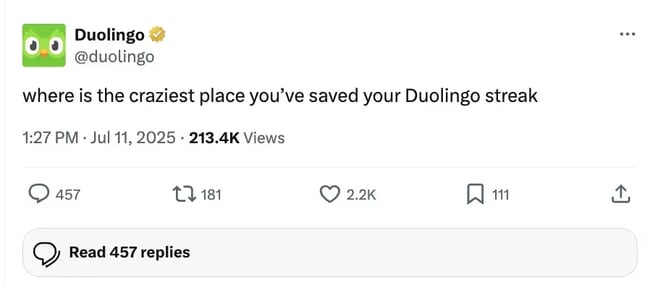Have you ever seen an online ad campaign that has absolutely nothing to do with you? I just saw one on Facebook — it was a brand I've never heard of promoting a product I’d never buy. I'm not the brand’s target audience, and that brand is missing out by not understanding who to market their product towards.
No company can market to everyone — so who are you selling to? That's the question that your target audience answers.
Good targeting speaks directly to a specific group, making viewers feel connected with the brand. Understanding target audiences is key to any successful marketing strategy.
Every product and service has a target audience, no matter how niche. In this article, I'll walk you through how to perform a target audience analysis for your brand.
Table of Contents
- What is a target audience?
- Target Market vs Target Audience
- Types of Target Audiences
- How to Find Your Target Audience
- Target Audience Examples
What is a target audience?
“Target audience” refers to a group of consumers characterized by shared qualities like demographic data, behaviors, interests, etc. Most companies and products will have multiple target audiences representing diverse products and user groups.
Brands identify their target consumers by articulating audience features to create a clear picture of who the potential customer is. This image clarifies brand messaging, focuses marketing efforts, and even guides what products to develop next.
For example, a wine company can't sell to both high-end wine aficionados and novice wine drinkers. Through target audience research, they could identify their target wine drinkers as those ages 24 to 30 who have an interest in wine but limited budgets. Knowing their audience, they can focus on appealing to those buyers instead of trying to appeal to everyone.
Is it the same as a buyer persona? No — your target audience represents your entire potential consumer group. Your buyer persona is a fictional representation of one target audience member.
Target Market vs Target Audience
Both target market and target audience are ways of grouping customers for segmentation. However, “target market” refers to the broader group of potential customers. The target audience sits within the target market and is a more specific segment.
Let's use an example of the IKEA in Pittsburgh, Pennsylvania:
- Target market: People in western Pennsylvania.
- Target audience: People in western Pennsylvania who want to buy budget-friendly furniture.
- One potential target segment: Expectant parents in western Pennsylvania who need budget-friendly nursery furniture.
After identifying a target segment, you then create buyer personas that represent the detailed emotions and needs of each customer segment.
Are the terms making more sense? Don‘t worry, this isn’t a test and you won't fail — as long as you focus on understanding the people who buy your product.
Types of Target Audiences
The world doesn't need more generic marketing campaigns. Personalization is key, and it’s something that modern consumers expect. A Boston Consulting Group (BCG) survey found that more than 80% of respondents reported wanting and expecting personalized experiences.
This is achieved by focusing on your brand's different target audience types. Here they are at a glance:
- Demographics: Who your customer is
- Customer journey stage: How well they know your brand
- Interests: How customers spend their time
- Subcultures: Relevant customer identities
- Values: What matters most to your buyers
Let's look at what makes these special, plus pull real-life examples to learn from.
Demographics
Demographic segmentation divides a market into smaller categories based on variable characteristics such as age, race, gender, marital status, income, education, and nationality.
Each demographic factor influences consumer behavior and product preferences. For example:
- Gender: Consumers often make fashion, beauty, and health purchases that align with their gender identity. Marketing strategies often differ when targeting men, women, or non-binary shoppers.
- Income: Economic status influences buying power, impacting what products or services consumers can afford.
- Age: Product preferences can vary significantly between different age groups, as do advertising media and ad campaigns.
For example, AARP's business strategy is built on age segmentation: the brand targets individuals who are at retirement age or pre-retirement age. This is clearly reflected in marketing materials like this Facebook post about “elderspeak.”
Demographic data is acquired through censuses, market surveys, and analytical tools.
Customer Journey Stages
The term “customer journey” refers to the different touchpoints that a customer has with a brand. Common stages include product awareness, consideration, purchase, and retention.
When targeting different points of the customer journey, your marketing should address questions like:
- Awareness: What is this product?
- Consideration: Why should I buy?
- Purchase: Is this product right for me?
- Retention: Why should I buy again?
This type of targeting is effective because it delivers the exact messaging people need, given their familiarity with the product.
Let's look at electrolyte company Liquid IV as an example and see how they create content targeting the different stages of the customer journey:
- What is Liquid IV? Awareness content educates prospective buyers on the product pain points and introduces the product as a solution.
- Why should someone buy it? Consideration content helps users understand product benefits.
- What's the best product for me right now? Purchase content shares product details and social proof.
- Why should I buy it again? Retention content encourages repeat purchases by sharing additional product uses.
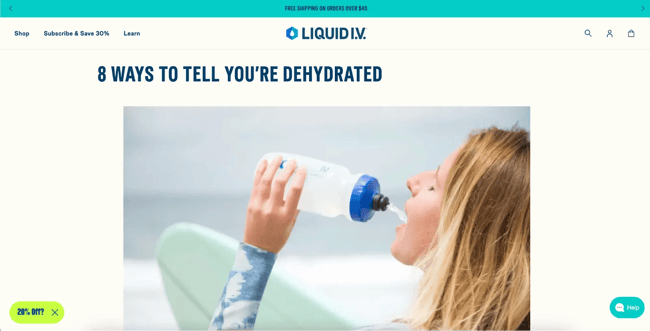
Interests
Interests represent the hobbies and activities that customers enjoy. Understanding customer interests helps you unearth buyer motivation and behaviors and connect with your audience in a relatable way.
One product can have different target groups based on customer interests. Let's use a bicycle as an example. Cyclist A might be interested in racing bikes. This customer wants to burn calories after work by cycling long distances. Cyclist B could enjoy a relaxing bike commute to work.
Understanding customer interests as they pertain to your product is crucial in reaching the right buyers.
Priority Bicycles caters to the interests of Cyclist B. That's clear through the company slogan: “bicycles for everyday riders.” This clear stance makes it very easy for cyclists to self-select if this company is right for their interests.
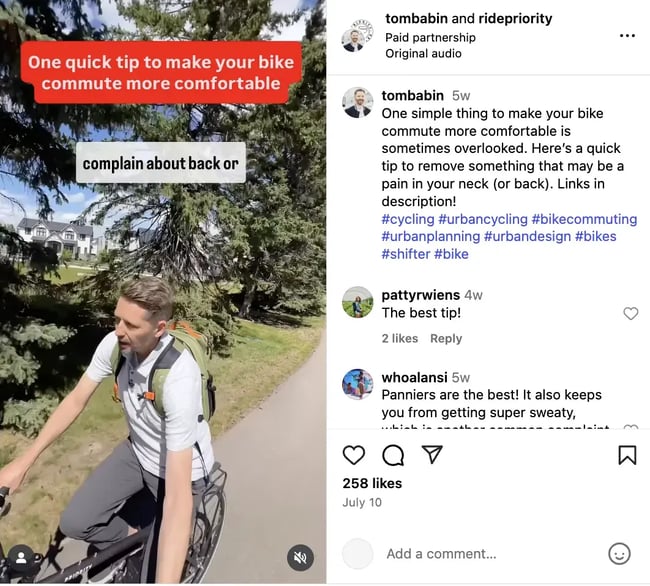
Subcultures
Subcultures represent interests, lifestyles, or identities that some of your customers share. They're similar to customer interests, but a subculture is directly tied to identity.
People define themselves by their subcultures, and each group has distinctive interests and needs. For example, not all parents are the same. Parents of adult children belong to a different subculture from parents of toddlers.
Understanding the subcultures within your target market helps sharpen marketing materials and make groups feel represented.
A real-life example of subculture targeting is Liquid Death, a canned water company. The company has been rooted in the music subculture from the beginning. It has maintained that connection to the music industry through social media content, company aesthetic, partnerships, and events.
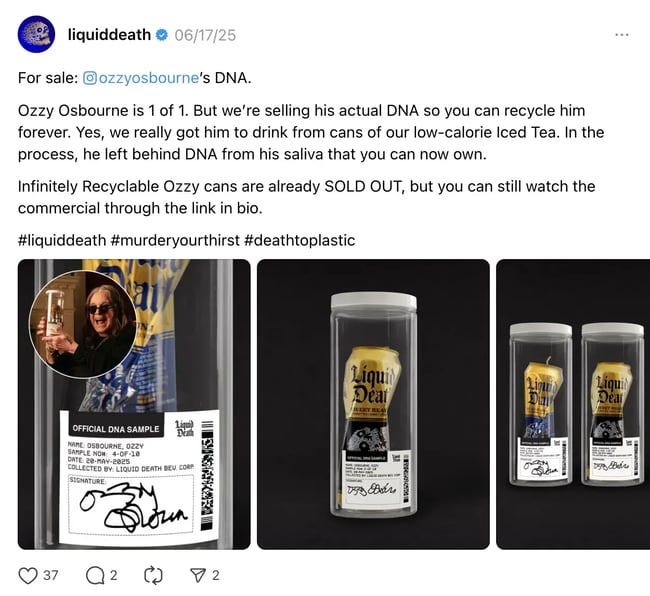
Values
Consumers have unique values that impact how they live their lives and which brands they monetarily support. Customers who align with a brand's values are more likely to try a product, repeat a purchase, and recommend the product to others. Some values include:
- Sustainability
- Transparency
- Social justice
- Accessibility
- Affordability
- Community
- Inclusion
- Diversity
These values are more than just talking points: they're deep insights into how consumers see themselves and who they aspire to be.
Examining customer values can also help you identify industry trends. For example, an interest in plastic-free product packaging is a manifestation of the public's growing awareness about ocean pollution and landfill contribution.
Nuud deodorant knows that its customers care about the environment and the chemicals they use on their bodies. The product aligns with customers' values by being plastic-free, natural, vegan, and cruelty-free.
Tip: This classification is less straightforward than demographics because it deals with subjective internal characteristics that can be harder to measure. Consider trying a customer survey or using social listening tools to gather data on what values align with your product.
How to Find Your Target Audience
Here are five steps you can take to define and refine your target audience.
1. Use HubSpot Analytics to learn more about your customers.
According to HubSpot's 2024 State of Marketing report, only 65% of marketers have high-quality data about their target audience. This leaves 35% who don't know their audience definitively.
HubSpot Analytics is an excellent tool for gathering demographic details about your audience, as well as real-time analytics about your marketing campaign's performance.
Here's some information you can find in the analytics dashboard.
Traffic Analytics
This tracks your website's performance and other digital assets. It provides metrics like page views, unique visitors, bounce rates, and session duration.
You can also see your traffic sources (organic, direct, referrals, social media, etc.), which helps you understand which channels are driving the most engagement.
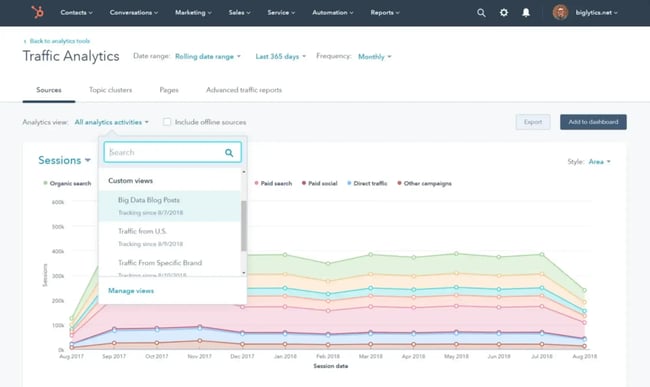
Conversion Analytics
HubSpot allows you to track how well your landing pages and other conversion tools are performing. This includes data on form submissions, lead conversions, and the effectiveness of different calls-to-action (CTAs).
You can also analyze the conversion paths to optimize the steps your visitors take from entering the site to becoming leads to becoming paid customers.
Campaign Analytics
Easily measure the performance of each marketing campaign you're running inside of HubSpot. This includes impressions, clicks, conversions, sales, and ROI. This helps you gauge which campaigns are the most effective.
Custom Reports
HubSpot allows you to create custom reports that fit specific needs. You can pull together various data points from across marketing, sales, and service platforms to create comprehensive reports to meet your unique business requirements.
Pro tip: If you're not using HubSpot analytics, you can connect your website to Google Analytics to find demographic data about your target audience, including their age, gender, interests, lifestyle, nationality, and more.
2. Use website data to gauge audience interests.
Which website pages are getting the most views, shares, and comments? Both the thriving and floundering pages contain valuable behavioral insights for you to learn from.
Start by learning from the top performers. Are there themes between the most popular pages? How are users finding them? How long do users spend on the page, and how far down do they scroll? After reading, do they click around or become an email subscriber?
Pro tip: Implement a streamlined navigation menu or sidebar that prominently features your popular content so visitors can easily find these thriving pages.
Some businesses highlight their top-performing content on their website in a “trending” or “most popular” section, like Glossier's blog:
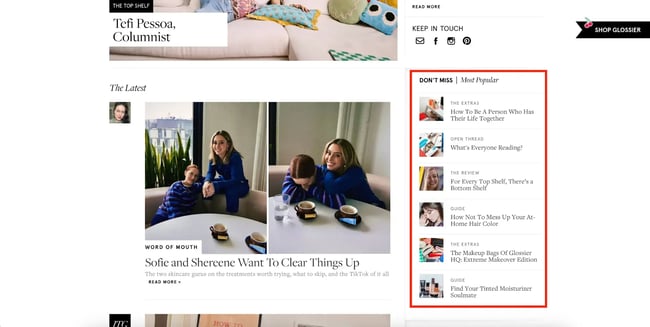
Then, analyze underperforming content. Are there themes between which pages get the least traffic? Are they visible on the website, or are they buried? Are they optimized for search? Is it possible that the pages with low readership are aligned with your audience, but the pages aren't being discovered?
I‘ve found that many businesses have quality content buried deep in their blog archives. If you find old pieces aren’t being read but are still valuable, update them for improved search visibility.
3. Analyze social media data for additional insights.
Social media channels collect different data from your website that can include robust insights into customer demographics and content preferences.
Analyze two types of social media data:
- Demographic data: Where do customers live? How old are they?
- Content preferences: What do viewers engage most with? What attracts the most new viewers? What‘s working and what’s not?
Every social channel is different and has a diverse audience, so it's essential to look at your analytics across all social platforms. Here's an example of some of the insights you can get from Facebook Analytics:
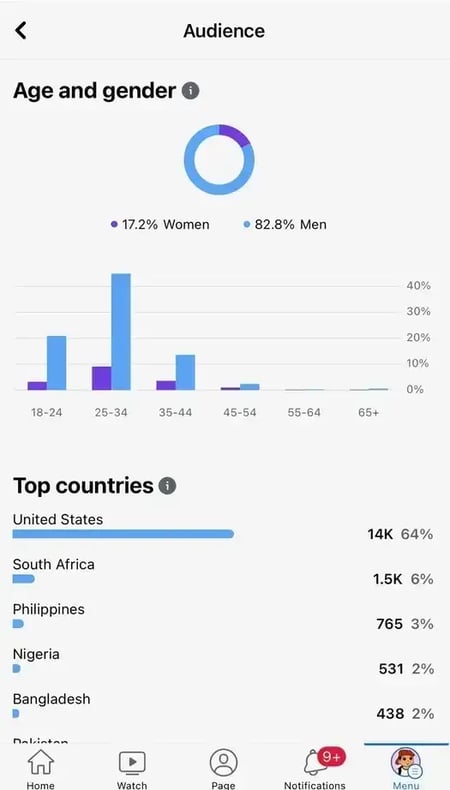
Pro tip: Some platforms, like Facebook, allow you to use detailed demographic information to segment your audience and customize your marketing campaigns. You can effectively tailor your content, messaging, and advertising strategies to match the characteristics and preferences of different audience segments.
Free Market Research Kit
5 Research and Planning Templates + a Free Guide on How to Use Them in Your Market Research
4. Engage with social media followers.
Social media is a readily available, free place to conduct market research. Engage with your audience through surveys, interactive polls, and “ask us anything” questionnaires.
Use this invaluable two-way medium to ask questions like:
- How are they using your product?
- What's their biggest complaint related to the problem you solve?
- How often do they use your product?
This can be done directly on social media platforms — Instagram Stories is probably the most popular place. Alternatively, you can create a formal survey and ask social media followers to participate. Remember: all engagement is valuable, whether it's positive or negative.
Pro tip: You can maximize engagement by showcasing the results of your questionnaires. This signals to your audience that their input is valued, which enhances loyalty and attracts new followers.
Here's a great survey example from budget bus company FlixBus:
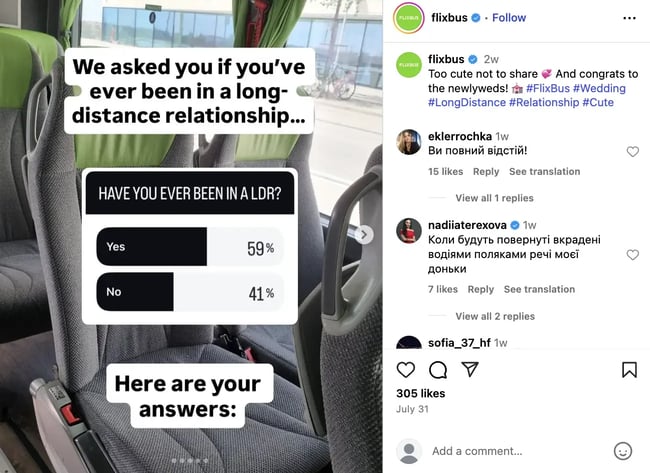
FlixBus' social media content aligned perfectly with its audience: budget travelers who love a good deal. As a customer, I feel seen by their humor and surveys.
5. Articulate your inverted audience.
Sometimes the details of a well-defined target audience emerge most clearly when describing who you aren't targeting. What consumers would be a bad fit for your brand? Who are you trying to repel? This is also known as a negative persona.
Let's look at two contrasting water brands as an example. First up is Boxed Water, which targets consumers who are interested in the environment, wellness, and simplicity.
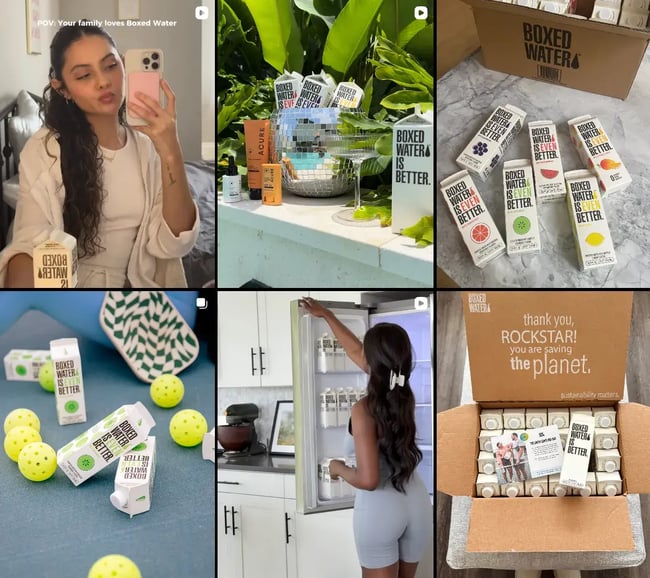
Let’s compare Boxed Water to Evian Water. Evian might describe its customers as people who value sports, luxury food, and premium events. Seeing the Instagram feeds side-by-side helps sharpen the qualities that make these brands unique.
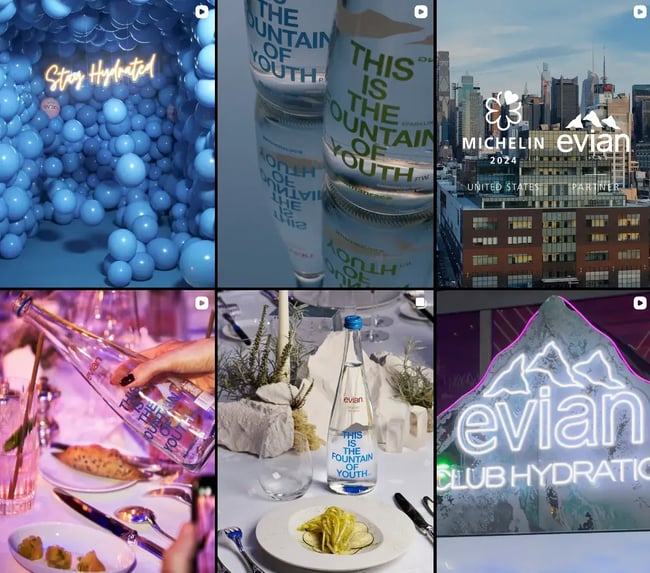
Remember this inverted thinking exercise as we look at examples below. I pulled five real-life target audience examples and included contrasting brands for each one to help make the audience crystal clear.
Target Audience Examples
Let‘s take the concepts we’ve reviewed above and see how they manifest in the examples below.
1. Aldi
Aldi is a budget supermarket chain that appeals to practical shoppers who prioritize savings over style.
The company‘s approach to audience targeting works because of its focus on the average consumer’s everyday needs. The majority of the store is stocked with staples instead of endless SKUs and brand names. One section of the store (nicknamed the “Aldi finds” section) is stocked with random rotating items that range from underwear to seasonal cookies to dorm room decor.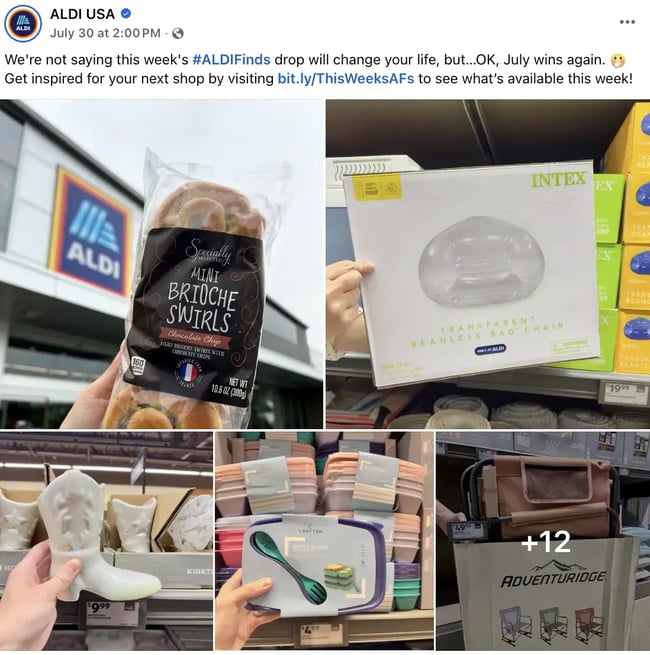
Aldi‘s marketing doesn’t make buyers aspire to put together a perfect Instagram-worthy dinner or transform their health. Instead, they lean into budget cooking and life's everyday chaos. Their marketing is relatable and laughs along with viewers, like this post on Threads:
Who isn't Aldi trying to target? Aesthetic shoppers (like Trader Joe's) or health-first consumers (like Whole Foods).
What I like: When Aldi first became popular where I live, it was known as the store with the weird layout and no shopping bags. The company didn't try to blend with the competition: it built a relationship with consumers based on reliable prices and food quality.
2. Duolingo
Duolingo is a language learning app that uses humor and pop-culture relevance to appeal to Gen Z and millennial consumers who want to dabble in language learning.
Have a look at Duolingo's marketing channels and you may ask yourself “What does any of this have to do with language learning?” The answer: not much.
Instead of sharing grammar tips, the marketing focuses on establishing the brand as a piece of pop culture. Language learning is typically rooted in a cultural interest in the language you're learning. But Duolingo understands that casual language learning is a cultural shift in itself, from formal to fun.
Duolingo's approach to audience targeting works because of its emphasis on progress instead of fluency. Gamification is a key piece of its brand and how it differentiates itself from competitors.
Here‘s an example of a viral TikTok video that aligns learning Korean on Duolingo with Netflix’s popular show Squid Game:
Who isn't Duolingo trying to attract? Serious language learners who want to develop conversation skills (like Rosetta Stone).
What I like: As a Duolingo user (currently practicing Dutch), I don't expect to gain language fluency on the app in a few minutes a day. I just enjoy the satisfaction of daily practice, no matter how small.
3. Dunkin'
This company‘s understanding of its target audience is apparent even in the name. Dunkin’, previously Dunkin' Donuts, underwent a rebrand in 2018. It pivoted away from its sugary namesake and embraced what its audience loved most: coffee to help you through the daily grind.
Dunkin‘s approach to audience targeting works because they understand how their consumers use their product: Dunkin’ knows that users love grabbing a coffee on their way to work.
They position themselves as being embedded in customers' busy routines, even with their slogan: “America runs on Dunkin'.” This philosophy oozes out of Dunkin's funny, relatable social media content: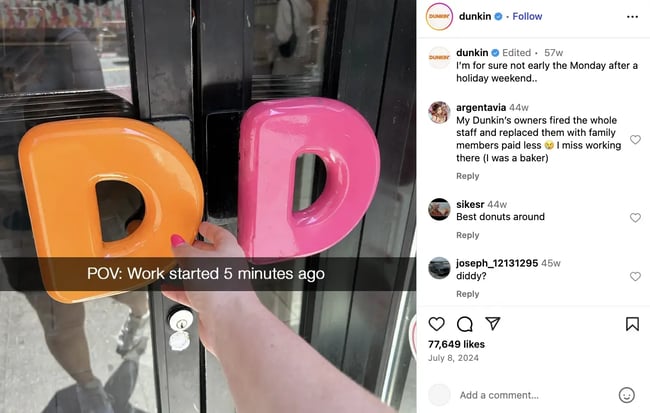
Who isn't Dunkin' trying to attract? Coffee drinkers who want to get comfy with a cup of specialty coffee in a stylish setting (like Starbucks).
What I like: Dunkin‘s rebrand showed that companies can successfully pivot when the customer data shows that consumers are moving in a new direction. Follow customers’ leads instead of trying to tell them where to go.
4. Planet Fitness
Planet Fitness is a gym chain that positions itself as a “Judgement Free Zone” for people of all fitness levels.
Their approach to audience targeting works because they understand that their customers experience gymtimidation: anxiety about going to the gym. This is often rooted in fear of judgment or uncertainty about how to use the machinery.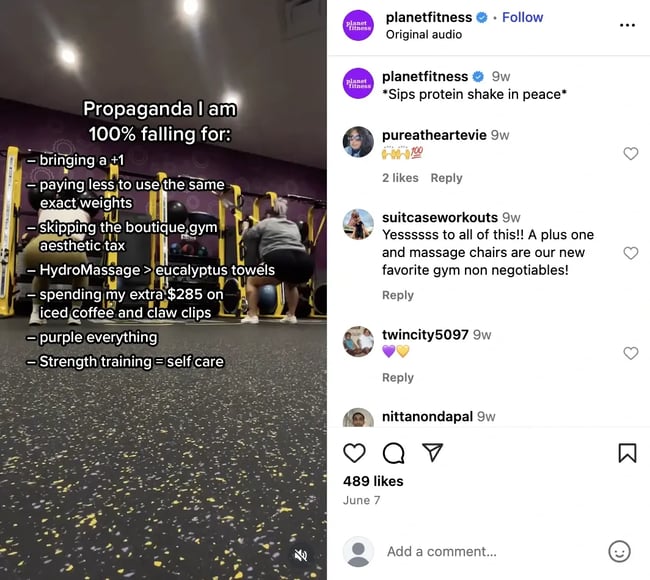
On social media, Planet Fitness doesn't share weight loss before-and-after photos or six-pack abs for motivation. They focus on the emotional gains of going to the gym and making exercise feel accessible.
Here's an example of mobility training the company shared on YouTube that can be completed at home without even needing a gym membership:
Who isn't Planet Fitness trying to attract? People interested in a boutique class experience (like SoulCycle) or intense lifting enthusiasts (Gold's Gym).
What I like: The emotional connection that Planet Fitness builds with its targeting is so effective. They found their unique proposition and went all in on it, from their gym design to their social media content, where they help people start moving even from home. That inclusivity helps foster long-term brand loyalty.
5. Ben & Jerry’s
Ben & Jerry's is an ice cream brand that appeals to socially conscious consumers who prefer to buy from values-based brands.
The company takes strong stances on public issues, even when those issues have nothing to do with selling ice cream.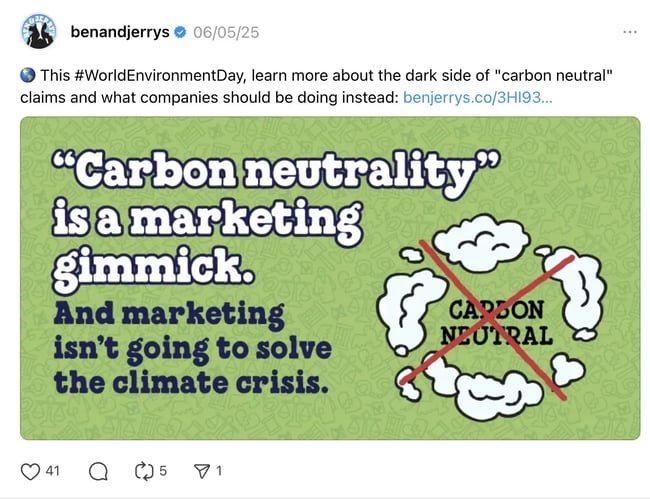
Blending ice cream with social issues alienates some potential customers. So why bother? Consumers know what Ben & Jerry's stands for, and this attracts loyal, aligned customers. The company values strengthen its customer relationships.
Instead of just being normal ice cream, the company positions itself as ice cream with a cause. Here's an example from the 2018 “Pecan Resist” campaign (word play on the phrase “we can resist”):
Who isn't Ben & Jerry's targeting? Healthy shoppers (like Halo Top) or people treating themselves to a pleasure (like Magnum).
Why this value targeting works: One-off social justice campaigns easily backfire or feel performative. Ben & Jerry's stance works because the company has a decades-long history of activism. As a result, the values-driven marketing messages have built brand loyalty.
Identify your target audience like a pro.
Consumers don't want to see ads for products they’d never use. And no company wants to waste ad spend on the wrong people.
I hope all of the real-life examples of audience targeting helped you recognize the hidden mechanics behind every brand's relationship with its viewers.
The steps I outlined above will help you stop focusing on the mass market and invest in finding your desired customers.
Are you ready to dive in? Use the free HubSpot Market Research Kit to help you dig deeper. Inside, you'll find an instructional guide, SWOT analysis template, survey template, focus group template, and more.
Editor's note: This post was originally published in January 2020 and has been updated for comprehensiveness.

